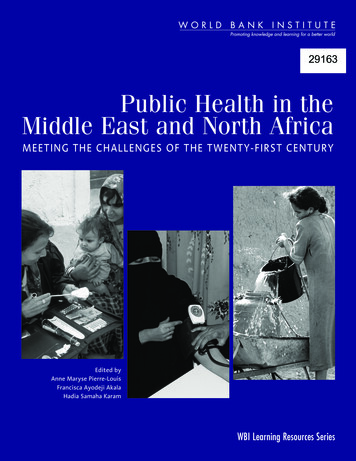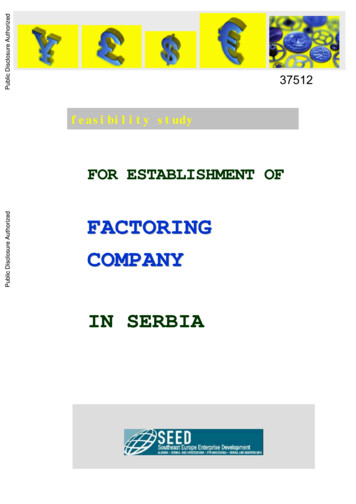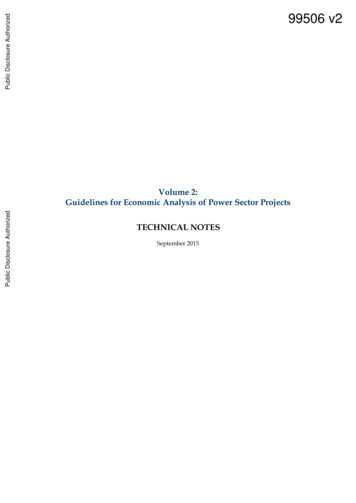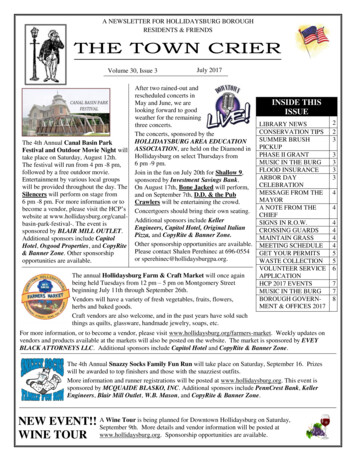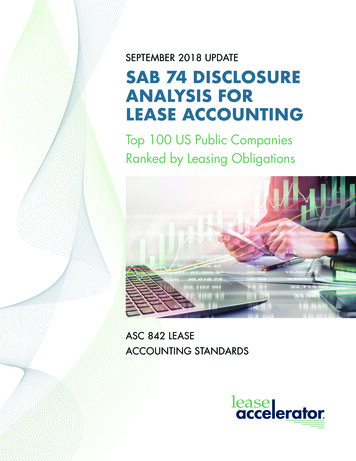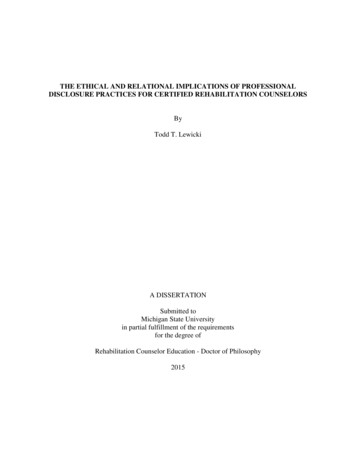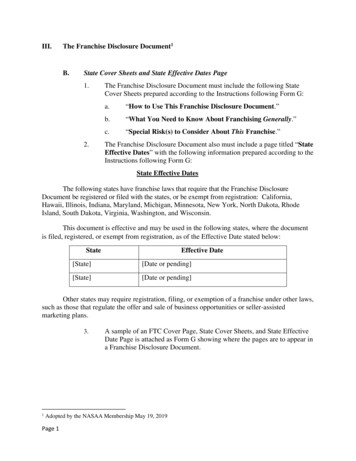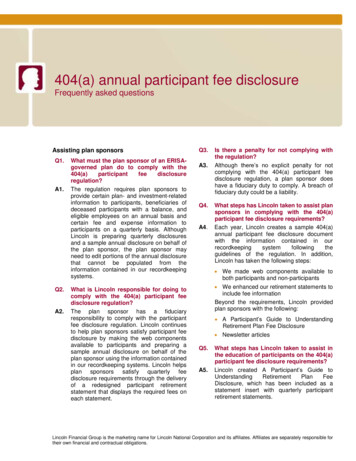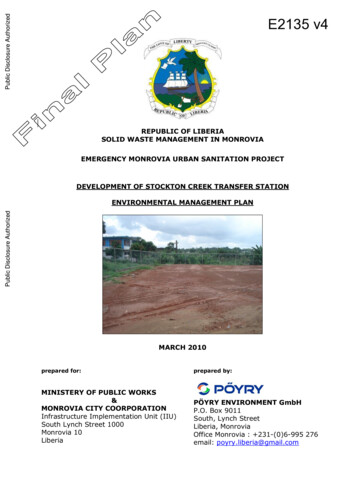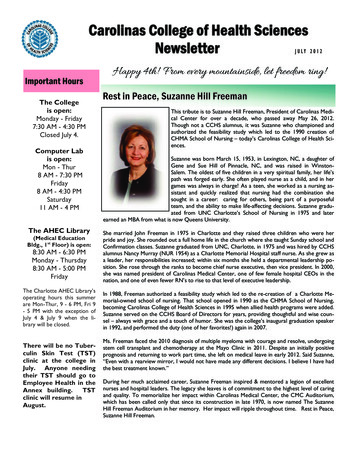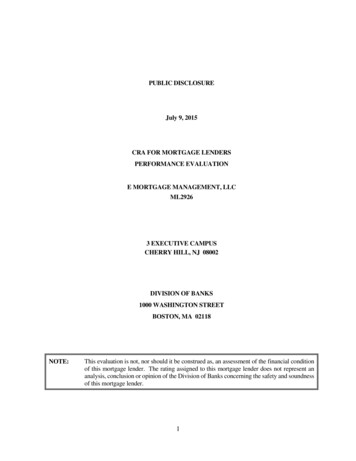
Transcription
PUBLIC DISCLOSUREJuly 9, 2015CRA FOR MORTGAGE LENDERSPERFORMANCE EVALUATIONE MORTGAGE MANAGEMENT, LLCML29263 EXECUTIVE CAMPUSCHERRY HILL, NJ 08002DIVISION OF BANKS1000 WASHINGTON STREETBOSTON, MA 02118NOTE:This evaluation is not, nor should it be construed as, an assessment of the financial conditionof this mortgage lender. The rating assigned to this mortgage lender does not represent ananalysis, conclusion or opinion of the Division of Banks concerning the safety and soundnessof this mortgage lender.1
GENERAL INFORMATIONMassachusetts General Laws chapter 255E, section 8 and the Division of Banks’ (Division) regulation 209CMR 54.00 et seq., Mortgage Lender Community Investment (CRA), require the Division to use its authoritywhen examining mortgage lenders subject to its supervision who have made 50 or more home mortgage loansin the last calendar year, to assess the mortgage lender’s record of helping to meet the mortgage credit needs ofthe Commonwealth, including low- and moderate-income neighborhoods and individuals, consistent with thesafe and sound operation of the mortgage lender. Upon conclusion of such examination, the Division mustprepare a written evaluation of the mortgage lender’s record of meeting the credit needs of the Commonwealth.This document is an evaluation of the CRA performance of E Mortgage Management, LLC (“E Mortgage”)prepared by the Division, the mortgage lender’s supervisory agency, as of July 9, 2015.SCOPE OF EXAMINATIONAn evaluation was conducted using examination procedures, as defined by CRA. A review of the Division’srecords, as well as the mortgage lender’s public CRA file, did not reveal any complaints related to CRA.The CRA examination included a comprehensive review and analysis, as applicable, of E Mortgage’s:(a) Origination of loans and other efforts to assist low- and moderate-income residents, withoutdistinction, to be able to acquire or to remain in affordable housing at rates and terms that arereasonable considering the lender’s history with similarly-situated borrowers, availability ofmortgage loan products suitable for such borrowers, and consistency with safe and sound businesspractices;(b) Origination of loans that show an undue concentration and a systematic pattern of lending resultingin the loss of affordable housing units;(c) Efforts working with delinquent residential mortgage customers to facilitate a resolution of thedelinquency; and(d) Other efforts, including public notice of the scheduling of examinations and the right of interestedparties to submit written comments relative to any such examination to the Commissioner as in thejudgement of the Commissioner reasonably bear upon the extent to which a mortgage lender iscomplying with the requirements of fair lending laws and helping meet the mortgage loan creditneeds of communities in the Commonwealth.CRA examination procedures were used to evaluate E Mortgage’s community investment performance. Theseprocedures utilize two performance tests: the Lending Test and the Service Test. This evaluation consideredE Mortgage’s lending and community development activities for the period of January 1, 2013, throughDecember 31, 2014. The data and applicable timeframes for the Lending Test and the Service Test arediscussed below.The Lending Test evaluates the mortgage lender’s community investment performance pursuant to thefollowing five criteria: lending to borrowers of different incomes, geographic distribution of loans, innovativeand flexible lending practices, fair lending, and loss of affordable housing.Home mortgage lending for 2013 and 2014 is presented in the geographic distribution, lending to borrowers ofdifferent incomes and the minority application flow tables. Comparative analysis of the mortgage lender’slending performance for the year of 2014 is provided as it is the most recent year for which aggregate HMDAlending data is available. The aggregate lending data is used for comparison purposes within the evaluationand is a measure of loan demand. It includes lending information from all lenders required to report application2
information pursuant to the Home Mortgage Disclosure Act (HMDA) which originated loans in theCommonwealth of Massachusetts.In addition to gathering and evaluating statistical information relative to a mortgage lender’s loan volume, theCRA examination also reflects an in depth review of the entity’s mortgage lending using qualitative analysis,which includes, but is not limited to: an assessment of the suitability and sustainability of the mortgage lender’sloan products by reviewing the lender’s internally maintained records of the delinquencies and defaults as wellas information publicly available through the Federal Reserve Banks and through local Registries of Deeds andthrough other sources available to the examination team. The examination included inspection of individualloan files for review of compliance with consumer protection provisions and scrutiny of these files for theoccurrence of disparate treatment based on a prohibited basis.The Service Test evaluated the mortgage lender’s record of helping to meet the mortgage credit needs byanalyzing the availability and effectiveness of a mortgage lender’s systems for delivering mortgage loanproducts, the extent and innovativeness of its community development services, and, if applicable, lossmitigation services to modify loans and/or efforts to keep delinquent home borrowers in their homes.3
MORTGAGE LENDER’S CRA RATING:This mortgage lender is rated “Satisfactory.” The distribution of borrowers, given the demographics of Massachusetts, reflects an adequate recordof servicing the credit needs among individuals of different income levels, including those of lowand moderate-income. The geographic distribution of the mortgage lender’s loans reflects an adequate dispersion in lowand moderate-income census tracts as it is reflective of the distribution of owner occupied housing inthose census tracts. E Mortgage offers a limited number of flexible lending products, which are provided in a safe andsound manner to address the credit needs of low- and moderate-income individuals. Fair lending policies are considered reasonable. No complaints were received during the evaluationperiod. The mortgage lender provides an effective delivery of mortgage lending services throughout theCommonwealth. There were no community development services offered by E Mortgage during the examinationperiod.4
PERFORMANCE CONTEXTDescription of Mortgage LenderE Mortgage Management, LLC was incorporated in the state of New Jersey in August 21, 2002, and wasregistered in Massachusetts on March 9, 2004. The mortgage lender was granted a Mortgage Lender licenseby the Division of Banks on November 9, 2004. E Mortgage’s main office is located at 3 Executive Campusin Cherry Hill, New Jersey. E Mortgage is licensed in 21 states and has additional office locations inCalifornia, Connecticut, Florida, North Carolina, New Jersey, Pennsylvania, and Virginia.E Mortgage offers a variety of mortgage loan products to meet the needs of the Commonwealth’s borrowerswhich include, Fixed Rate and Adjustable Rate, Federal Housing Administration (FHA), Veterans’Administration (VA), United States Department of Agriculture (USDA), and HARP 2.0 loans. In additionto their retail business, the mortgage lender also receives applications from mortgage brokers.Underwriting of Massachusetts loans and major functions in the loan process are centralized at the corporateoffice. Approved loans are funded through an established warehouse line of credit and are generally sold,on a servicing released basis, to secondary market investors.During the period of 2013 and 2014, E Mortgage originated 301 loans totaling approximately 80.6 millionin the Commonwealth of Massachusetts.Demographic InformationThe CRA regulation requires mortgage lenders to be evaluated on their performance within theCommonwealth of Massachusetts. Demographic data is provided below to offer contextual overviews ofeconomic climate along with housing and population characteristics for the Commonwealth ofMassachusetts.2010 CENSUS DEMOGRAPHIC INFORMATIONDemographic CharacteristicsAmountGeographies (Census Tracts)Population by GeographyOwner-Occupied Housing by GeographyFamily Distribution by Income LevelDistribution of Low and Moderate IncomeFamiliesMedian Family 1.19.23.122.215.7 86,272Households Below Poverty Level2014 HUD Adjusted Median FamilyIncome11.1% 48.320.640.9Upper%27.930.235.640.717.5Median Housing ValueUnemployment Rate2015 HUD Adjusted MedianFamily IncomeN/A%1.30.20.00.00.0373,2064.9%* 88,102Source: 2010 US Census; *as of 12/31/2014Based on the 2010 Census, the Commonwealth’s population was above 6.5 million people with a total of2.8 million housing units. Of the total housing units, 1.6 million or 57.7 percent are owner-occupied,904,078 or 32.5 percent are rental-occupied, and 9.8 percent are vacant units. According to the 2010 Censusthere are 2.5 million households in the Commonwealth. The median household income was 83,495 for2014. In addition, over 39 percent of households are now classified as low- and moderate-income. Over5
11 percent of the total number of households are living below the poverty level. Individuals in thesecategories may find it difficult to qualify for traditional mortgage loan products.Households classified as “families” totaled slightly over 1.6 million. Of all family households, 22.2 percentwere low-income, 16.5 percent were moderate-income, 20.6 percent where middle-income, and 40.7percent were upper-income. The median family income reported by the 2010 Census was 86,272. TheHousing and Urban Development (HUD) adjusted median family income was 83,495 in 2014. Theadjusted median family income is updated yearly and takes into account inflation and other economicfactors.The Commonwealth of Massachusetts contained 1,474 Census tracts. Of these, 164 or 11.1 percent arelow-income; 281 or 19.0 percent are moderate-income; 598 or 40.6 percent are middle-income; 411 or 27.9percent are upper-income; and 20 or 1.4 percent are NA or have no income designation. The tracts with noincome designation are located in areas that contain no housing units and will not be included in thisevaluation since they provide no lending opportunities. These areas are made up of correctional facilities,universities, military installations, and uninhabited locations such as the Boston Harbor Islands.Low-income is defined as individual income that is less than 50 percent of the area median income.Moderate-income is defined as individual income that is at least 50 percent and less than 80 percent of thearea median income. Middle-income is defined as individual income that is at least 80 percent and lessthan 120 percent of the area median income. Upper-income is defined as individual that is more than 120percent of the area median income.The median housing value for Massachusetts was 373,206 according to the 2010 Census. Theunemployment rate for the Commonwealth of Massachusetts as of December 31, 2014, stood at 4.9 percentwhich was a decrease from December 31, 2013, at which time it stood at 6.2 percent. Employment rateswould tend to affect a borrower’s ability to remain current on mortgage loan obligations and also correlatesto delinquency and default rates.6
CONCLUSIONS WITH RESPECT TO PERFORMANCE TESTSLENDING TESTE Mortgage’s lending efforts are rated under five performance criteria: Borrower Characteristics,Geographic Distribution, Innovative or Flexible Lending Practices, Fair Lending Policies and Procedures,and Loss of Affordable Housing. The following details the data compiled, reviewed and conclusions on EMortgage’s lending.E Mortgage’s Lending Test performance was determined to be “Satisfactory” at this time.I.Borrower CharacteristicsThe distribution of loans by borrower income levels was reviewed to determine the extent to which themortgage lender is addressing the credit needs of the Commonwealth’s residents.E Mortgage achieved an adequate record of serving the mortgage credit needs among borrowers of differentincome levels based on the area’s demographics and a comparison to aggregate lending data in Massachusetts.The following table shows the distribution of HMDA-reportable loans to low-, moderate-, middle- andupper-income borrowers in comparison to the aggregate data (exclusive of E Mortgage) and the percentageof total families within the Commonwealth within each respective group.Distribution of HMDA Loans by Borrower rNA*Total2013% ofFamilies22.316.720.840.20.0100.02013E Mortgage#3914502782014AggregateLending Data(% of 2014% ofFamilies22.216.520.640.70.0100.02014E rce: 2013 & 2014 HMDA Data and 2010 U.S. CensusE Mortgage’s lending increased from 2013 to 2014 resulting in increased lending to both low- andmoderate-income borrowers which was substantially above the aggregate in 2014. The percentage oflending to low- and moderate- income borrowers was also above the percentage of families in 2014. Thelender made marked improvement in their lending to low- and moderate-income borrowers from theprevious year.7
II.Geographic DistributionThe geographic distribution of loans was reviewed to assess how well E Mortgage is addressing the creditneeds throughout the Commonwealth of Massachusetts’ low-, moderate-, middle-, and upper-incomecensus tracts.E Mortgage’s distribution of lending is considered adequate when compared to the demographics andaggregate lending data for the time period of January 1, 2013 through December 31, 2014.The table below shows the distribution of HMDA-reportable loans by census tract income level. Thelending activity is compared with the percent of owner-occupied housing units based on Censusdemographics and E Mortgage’s 2013 and 2014 home mortgage lending performance is compared toaggregate lending performance in each year.Distribution of HMDA Loans by Income Category of the Census TractCensus TractIncome Level2013% TotalOwner-Occ.HousingUnits2013E Mortgage2014Aggregate LendingData(% of #)2014% TotalOwner-Occ.HousingUnits2014E 0.078100.0100.0100.0223100.0Source 2013 & 2014 HMDA Data and 2010 U.S. CensusAlthough E Mortgage increased their overall lending from 2013 to 2014, lending to low- and moderateincome borrowers remained comparable to the previous year. E Mortgage’s lending to low-incomeborrowers was below the aggregate and lending to moderate-income borrowers was slightly below theaggregate in 2014. The percentage of lending in low- and moderate-income census tracts was comparableto the percentage of total owner-occupied housing units during 2014.The highest percentage of originations were in the middle- and upper-income census tracks for both yearsexamined. Since over 80 percent of the total owner-occupied housing units are located in middle- andupper- income census tracts, it is reasonable to find the majority of originations occurring within thesespecified census tracts.III.Innovative or Flexible Lending PracticesE Mortgage offers a limited number of flexible lending products, which are provided in a safe and soundmanner to address the credit needs of low- and moderate-income individuals or geographies in theCommonwealth.E Mortgage is a Housing and Urban Development direct endorsement mortgage lender of Federal HousingAdministration (FHA) insured mortgages. FHA products provide competitive interest rates and smallerdown payment for low- and moderate-income first time homebuyers and existing homeowners. During the8
review period E Mortgage originated 14 FHA loans totaling 3.9 million. Of these, one loan benefited alow-income individual and one loan was originated in a moderate census tract.E Mortgage is also a Veterans Administration authorized lender. The VA home Loan Guarantee Programis designed specifically for service members, veterans or their qualified surviving spouses. The programoffers low closing costs, no down payment, and no private mortgage insurance. During the review period,E Mortgage originated one VA loan totaling 258,000. No loans originated benefited low- to moderateincome individuals or geographies.The USDA Rural Housing Program is an innovative loan program for eligible homebuyers in ruraldesignated areas. For home purchase transactions, the program offers fixed interest rates and 100 presentfinancing with no down-payment required. E Mortgage also offers the USDA program, although did notoriginate any loans within the period examined.IV.Fair LendingThe Division examines a mortgage lender’s fair lending policies and procedure pursuant to RegulatoryBulletin 1.3-106. The mortgage lender’s compliance with the laws relating to discrimination and otherillegal credit practices was reviewed, including the Fair Lending Act and the Equal Credit Opportunity Act.The review included, but was not limited to, review of written policies and procedure, interviews with EMortgage’s personnel, and individual file review. No evidence of disparate treatment was identified.E Mortgage has established a reasonable record relative to fair lending policies and practices.Fair lending is incorporated in E Mortgage’s company-wide policies and procedures and apply to allpersonnel. Employees regularly participate in on-line courses regarding fair lending, equal creditOpportunity act, and HMDA as well as agency and investor required trainings.Minority Application FlowE Mortgage’s Loan Application Registers for 2013 and 2014 were reviewed to determine if the applicationflow from the different racial and ethnic groups within the Commonwealth was reflective of the area’sdemographics.During 2014, E Mortgage received 318 HMDA-reportable applications from within theCommonwealth of Massachusetts. Of the 21 racial minority applications received in 2014, 14 or66.7 percent resulted in originations and none resulted in a denial. In regard to 19 applicants ofHispanic origin, 8 or 42.1 percent resulted in originations and 1 or 5.3 percent resulted in a denial.E Mortgage’s origination of racial minority applicants at 66.7 percent is above the aggregate of 64percent. The origination of ethnic minority applicants at 42.1 percent is bel ow the aggregateorigination rate of 60.9 percent.Demographic information for Massachusetts reveals the total ethnic and racial minority populationstood at 23.9 percent of the total population as of the 2010 Census. This portion of the populationis comprised of 9.6 percent Hispanic or Latino. Racial minorities consisted of 6.0 percent Black; 5.3percent Asian/Pacific Islander; .2 percent American Indian/Alaskan Native; and 2.8 percentidentified as Other Race.Refer to the table below for information on the mortgage lender’s minority application flow as wellas a comparison to aggregate lenders in the Commonwealth of Massachusetts. The comparison of9
this data assists in deriving reasonable expectations for the rate of applications the mortgage lenderreceived from minority applicants.RACEAmerican Indian/ Alaska NativeAsianBlack/ African AmericanHawaiian/Pac Isl.2 or more MinorityJoint Race (White/Minority)Total MinorityWhiteRace Not AvailableTotalETHNICITYHispanic or LatinoNot Hispanic or LatinoJoint (Hisp/Lat /Not Hisp/Lat)Ethnicity Not AvailableTotalMINORITY APPLICATION FLOW20132014E MortgageAggregate Data2014E 1.2100.0% of 61.3100.0Source: 2010 U.S. Census Data, 2013 & 2014 HMDA DataIn 2014, E Mortgage’s performance was below the aggregate’s performance for racial minorities and aboveethnic minorities. While the number of applications received from racial minorities increased from 2013to 2014, the overall percentage decreased during that time.V. Loss of Affordable HousingThis review concentrated on the suitability and sustainability of mortgage loans originated by E Mortgageby taking into account delinquency and default rates of the mortgage lender and those of the overallmarketplace. Information provided by the mortgage lender was reviewed as were statistics available ondelinquency and default rates for mortgage loans. Additionally, individual mortgage loans were trackedfor their status through local Registries of Deeds and other available sources including public records offoreclosure filings.A review of information and documentation, from both internal and external sources as partially describedabove, did not reveal lending practices or products that showed an undue concentration or a systematicpattern of lending, including a pattern of early payment defaults, resulting in the loss of affordable housingunits. Further, delinquency rates were found to be consistent with industry averages.10
SERVICE TESTThe Service Test evaluates a mortgage lender’s record of helping to meet the mortgage credit needs in theCommonwealth by analyzing both the availability and effectiveness of a mortgage lender’s systems fordelivering mortgage loan products; the extent and innovativeness of its community development services;and loss mitigation services to modify loans or otherwise keep delinquent home loan borrowers in theirhomes. Community development services must benefit the Commonwealth or a broader regional area thatincludes the Commonwealth.E Mortgage’s Service Test performance was determined to be “Needs to Improve” during the evaluationperiod.Mortgage Lending ServicesE Mortgage provides an effective delivery of mortgage lending services that are accessible to geographiesand individuals of different income levels in the Commonwealth. Customers can apply for a mortgage overthe phone or on the E Mortgage web site. Currently, E Mortgage does not maintain a retail branch presencewithin the Commonwealth of Massachusetts. The absence of retail branches may be an obstacle for someapplicants.Business development relies primarily on direct mail marketing in Massachusetts.E Mortgage also offers FHA, VA, and USDA loan products, but have originated minimal loans to low- andmoderate income individuals and geographies.The Lender does not regularly service mortgage loans, therefore, it would not work directly with delinquentborrowers. This review would not include an evaluation of loan mitigation and modification efforts as themortgage lender would not be accountable for such action. Lending practice and products did not show anundue concentration or systematic pattern of lending resulting in mortgage loans that were not sustainable.Community Development ServicesA community development service is a service that:(a) has as its primary purpose community development; and(b) is related to the provision of financial services, including technical servicesThe Commissioner evaluates community development services pursuant to the following criteria:(a) the extent to which the mortgage lender provides community development services; and(b) the innovativeness and responsiveness of community development services.During the exam period, E Mortgage did not participate in any community development services within theCommonwealth of Massachusetts.11
PERFORMANCE EVALUATION DISCLOSURE GUIDEMassachusetts General Laws Chapter 255E, Section 8, and 209 CMR 54.00, the Mortgage LenderCommunity Investment (CRA) regulation, requires all mortgage lenders to take the following actions within30 business days of receipt of the CRA evaluation of their mortgage lender:1) Make its most current CRA performance evaluation available to the public.2) Provide a copy of its current evaluation to the public, upon request. The mortgage lender isauthorized to charge a fee which does not exceed the cost of reproduction and mailing (ifapplicable).The format and content of the mortgage lender’s evaluation, as prepared by the Division of Banks,may not be altered or abridged in any manner. The mortgage lender is encouraged to include its responseto the evaluation in its CRA public file.The Division of Banks will publish the mortgage lender’s Public Disclosure on its website nosooner than 30 days after the issuance of the Public Disclosure.12
Description of Mortgage Lender E Mortgage Management, LLC was incorporated in the state of New Jersey in August 21, 2002, and was registered in Massachusetts on March 9, 2004. The mortgage lender was granted a Mortgage Lender license by the Division of Banks on November 9, 2004. E Mortgage's main office is located at 3 Executive Campus
